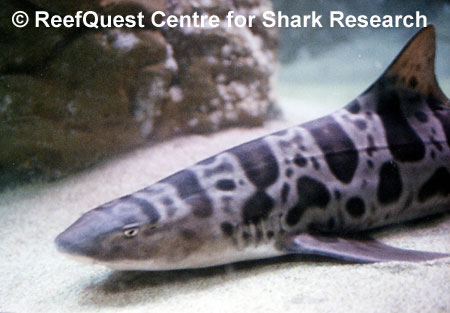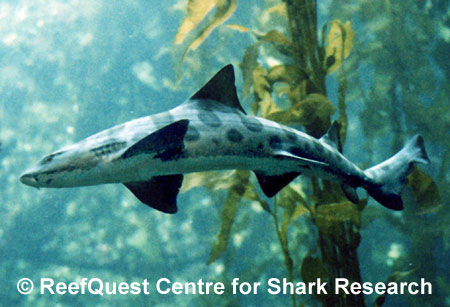Estuaries: Where the Land Meets the Sea
Leopard Shark
The handsomely marked Leopard Shark (Triakis semifasciata) is often encountered in California waters, usually by divers exploring rocky reefs or caught by recreational anglers off piers and wharves. But it is in the turbid estuarine environment where this attractive little hunter really shines.
Just the Facts:
Size:
Reproduction:
Diet:
Habitat: Estuaries, Sandy Plains, Rocky Reefs, Kelp Forests Depth: Intertidal to 300 ft (90 m) Distribution: Temperate Eastern Pacific, Tropical Eastern Pacific |
Food habits of the Leopard Shark have been most extensively studied in northern California waters. Classic studies in Elkhorn Slough, which empties via a large estuary into Monterey Bay, found that Leopard Sharks have a richly varied diet and employ several predatory ‘tricks’ to secure their meals. For example, Slough-inhabiting Leopard Sharks feed heavily on Fat Inn-Keeper Worms (Urechis caupo), which are forcefully sucked from their U-shaped burrows. Elsewhere in Elkhorn Slough, Leopard Sharks often mutilate burrowing clams by nipping off their fleshy siphons (breathing tubes which protrude conveniently through the sediment), completely ignoring the rest of the mollusc. In fact, it is not uncommon to capture Leopard Sharks with stomachs full of nothing but amputated clam siphons. When feeding on circling, densely packed schools of Northern Anchovies (Engraulis mordax) in San Francisco Bay, Leopard Sharks have been reported to circle in the opposite direction with their jaws agape, snapping up the baitfish that blunder into their mouths. The broad spectrum of food resources exploited by Leopard Sharks, as well as their adaptable feeding behavior, undoubtedly contribute to this species’ success in estuarine environments, for it relieves them of being dependent upon any one prey species.
But Leopard Sharks do not rule these murky waters uncontested. They share estuaries with, among other species, Shovelnose Guitarfish (Rhinobatos productus), Bat Rays (Myliobatis californicus), and the Brown Smoothhound Shark (Mustelus henlei). The Leopard Shark and Brown Smoothhound are closely related and would be expected to require similar resources. One study compared and contrasted the feeding habits of the Leopard Shark and the Brown Smoothhound in San Francisco Bay. It demonstrated that both species feed predominantly on shrimps, crabs, and fishes, but that Brown Smoothhounds hunt predominantly in rocky intertidal areas while the Leopard Shark tends to feed more in muddy areas of estuarine waters.

A recent study of blood and muscle characteristics of Leopard and Brown Smoothhound Sharks in Tomales Bay sheds some light on why these two closely-related species have such different feeding habits. In most respects, the blood chemistry and muscle composition of these two sharks are virtually identical. But the Leopard Shark differs dramatically from the Brown Smoothhound in having smaller and more numerous red blood cells, which transport oxygen to the brain, gut, swimming muscles and other tissues. The near-constant wave action of intertidal areas tends to keep the flood tide waters well oxygenated. Thus, a shark moving in with the tide would not require any special adaptations. In contrast, the legions of aerobic bacteria respiring away in the organic-rich muck of estuaries greedily consume oxygen from the water. Due to its smaller and more numerous red blood cells, the Leopard Shark is more efficient at absorbing and handling oxygen than the Brown Smoothhound. This enables the Leopard Shark to be an active predator in oxygen-poor estuarine waters where the Brown Smoothhound can barely get enough oxygen to meet its basic requirements.
Estuarine waters are often close to human population centres, which introduce new perils to an already precarious existence. When they are not filled in for use as shore-front real estate, estuaries are often used as convenient dumping grounds for human effluent and industrial waste. Due to their habit of nosing through and excavating bottom mud in search of buried prey, Leopard Sharks tend to concentrate pesticides, polychlorinated biphenyls (PCB’s), and other toxic chemicals in the liver. The long-term effects of these accumulated chemicals on Leopard Shark reproductive success are not known.


